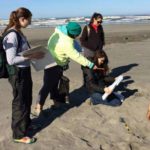 Citizen science projects are undoubtedly one of the more interesting aspects of crowdsourcing in the modern world. Thousands of people join communities to search for extraterrestrial life or track rainfall, all joined by a common hunt for the answer to various scientific questions. As all participants are volunteers, motivation is a key question for communities to explore, and it’s the focus of a new study from the University of Washington.
Citizen science projects are undoubtedly one of the more interesting aspects of crowdsourcing in the modern world. Thousands of people join communities to search for extraterrestrial life or track rainfall, all joined by a common hunt for the answer to various scientific questions. As all participants are volunteers, motivation is a key question for communities to explore, and it’s the focus of a new study from the University of Washington.
The research focused specifically on the Coastal Observation and Seabird Survey Team (COASST) project, which aims to train beachgoers the length of the West Coast to monitor their local beaches for dead birds.
The project has had around 4,500 volunteers during its 21-year history, with approximately 800 active volunteers today. The research builds upon previous work by the team into online citizen science projects, and this research found that the majority of participants try it out just once, with less than 10% enduring for longer than a year.
For the hands-on project however, the rate is much better, with 54% of volunteers proving to be active after a year. The team analyzed responses to surveys sent by the COASST recruitment and engagement team to understand why that was. The survey specifically sought to understand why people joined the project, and why they stuck with it.
The great outdoors
The analysis revealed that a primary motivation was to be outdoors and learn more about birds. Those with the longest participation built upon this with a strong desire to protect and monitor the beach, whilst helping to make scientific discoveries. For the long-termers, this ‘science identity’ was important as it helped bond the teams together. This prompted many of the volunteers to visit their local beaches, even if no birds had washed ashore for several months.
“We thought they would talk a lot about birds, and they did, but they actually talked more about the coastal environment, the beach and the ocean,” the researchers explain. “Place was either equally important or even more important to them than birds.”
The data also highlighted the social aspect of citizen science, with tasks such as communicating project results and recruiting other volunteers among the most important and enjoyable for the citizen scientists.
“Activities that help connect family members and friends, and provide opportunities to meet new people who share similar interests, can also be scientific in nature,” the researchers explain. “COASST fulfills both science and social interests for coastal residents.”
Lessons for other projects
The team believe that their findings hold a number of lessons for other citizen science projects, especially those where volunteers are hands-on rather than working virtually.
- Long-term participants tend to be motivated by a project’s mission and goals, and successful programs communicate scientific findings back to participants so that they can see their individual contribution as part of the big picture of project results.
- Experienced participants focus on where they conduct their project activities, indicating that sense of place is important to volunteers.
- Both new and long-term participants focused on their social interactions as a central part of project activities, suggesting that successful hands-on, citizen science combines high-quality scientific activity with building and maintaining social relationships.